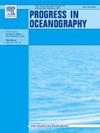西赤道太平洋年际涡旋动能变化的特征和动力学特征
IF 3.8
3区 地球科学
Q1 OCEANOGRAPHY
引用次数: 0
摘要
本研究基于卫星观测和模式输出结果,对赤道西太平洋涡旋动能(EKE)的年际变化进行了研究。结果表明,EKE 的年际变化非常剧烈,尤其是在北赤道逆流(NECC)区域和新几内亚以北,而且两种厄尔尼诺现象的变化也不尽相同。能量预算分析表明,EKE 的变化主要归因于与背景洋流有关的气压不稳定性。具体地说,高能 NECC 表现为向北移动和更强的蜿蜒路径,这有利于增强气压不稳定性导致的 EKE 变化。新几内亚沿岸流/暗流(NGCC/NGCUC)和赤道东流强度的年际波动导致了新几内亚以北显著的 EKE 年际变化。此外,两种厄尔尼诺现象下的 EKE 变化有以下明显特征:在东太平洋厄尔尼诺(EP-El Niño)事件期间,赤道西太平洋的 EKE 通常减弱,而在中太平洋厄尔尼诺(CP-El Niño)事件期间,新几内亚以北的 EKE 则增强。新几内亚以北的相反特征归因于风的作用以及在 CP-El Niño 事件中赤道沿线较强的东流。这些结果有助于更好地理解低频涡流与平均流之间的相互作用。本文章由计算机程序翻译,如有差异,请以英文原文为准。
Characteristics and dynamics of the interannual eddy kinetic energy variation in the Western Equatorial Pacific Ocean
The interannual variations of eddy kinetic energy (EKE) in the western equatorial Pacific Ocean are investigated based on satellite observations and model outputs in this study. Results reveal that the EKE exhibits vigorous interannual variations, especially in the region of North Equatorial Countercurrent (NECC) and north of New Guinea, and the variations differ between the two types of El Niño events. The energy budget diagnosis indicates that the EKE variations are mainly attributed to the barotropic instability associated with the background currents. Specifically, the energetic NECC behaves northward shift and a stronger meander path, which favors the enhancement of EKE variations due to the enhanced barotropic instability. The interannual fluctuations of the strength of the New Guinea Coastal Current/Undercurrent (NGCC/NGCUC) and the eastward current along the equator contribute to the significant EKE interannual variations north of New Guinea. Further, the distinct features of EKE variations in two types of El Niño events are as follows: EKE typically weakens in the western equatorial Pacific during Eastern Pacific El Niño (EP-El Niño) events, whereas it intensifies north of New Guinea during Central Pacific El Niño (CP-El Niño) events. The opposite features north of New Guinea are attributed to the wind work and a stronger eastward current along the equator in CP-El Niño events. These results can contribute to a better understanding of the low-frequency eddy-mean flow interactions.
求助全文
通过发布文献求助,成功后即可免费获取论文全文。
去求助
来源期刊

Progress in Oceanography
地学-海洋学
CiteScore
7.20
自引率
4.90%
发文量
138
审稿时长
3 months
期刊介绍:
Progress in Oceanography publishes the longer, more comprehensive papers that most oceanographers feel are necessary, on occasion, to do justice to their work. Contributions are generally either a review of an aspect of oceanography or a treatise on an expanding oceanographic subject. The articles cover the entire spectrum of disciplines within the science of oceanography. Occasionally volumes are devoted to collections of papers and conference proceedings of exceptional interest. Essential reading for all oceanographers.
 求助内容:
求助内容: 应助结果提醒方式:
应助结果提醒方式:


